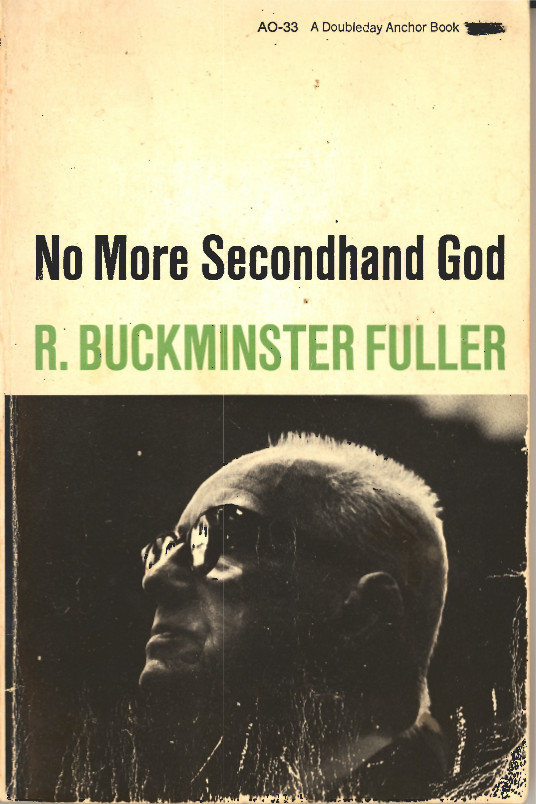R. Buckminster Fuller: No More Secondhand God and Other Writings (1963/1971)
Filed under book | Tags: · art, machine, science, technology

These prose pieces and prose-poem essays show the development of the thinking of R. Buckminster Fuller, the world-famous inventor of the Geodesic dome. Fuller himself aptly describes these pieces as “mental mouthfuls and ventilated prose.” The title poem No More Secondhand God, written in 1940, proposes practical means for daily or hourly telephone voting by democracy. In another prose-poem Fuller formulates his “comprehensive anticipatory design science.” Each of the pieces in this book is an adventure for the mind; each “generates sublimity of those poetical moments of man’s fleeting glimpses of the omniscient.”
Originally published by Southern Illinois University Press, 1963
Publisher Anchor Books, New York, 1971
145 pages
PDF (no OCR)
Comment (0)Stephen Graham: Cities Under Siege: The New Military Urbanism (2010)
Filed under book | Tags: · city, iraq, israel, military, neoliberalism, security, surveillance, technology, terrorism, urbanism, war

A powerful exposé of how political violence operates through the spaces of urban life.
Cities are the new battleground of our increasingly urban world. From the slums of the global South to the wealthy financial centers of the West, Cities Under Siege traces the spread of political violence through the sites, spaces, infrastructure and symbols of the world’s rapidly expanding metropolitan areas.
Drawing on a wealth of original research, Stephen Graham shows how Western militaries and security forces now perceive all urban terrain as a conflict zone inhabited by lurking shadow enemies. Urban inhabitants have become targets that need to be continually tracked, scanned and controlled. Graham examines the transformation of Western armies into high-tech urban counter-insurgency forces. He looks at the militarization and surveillance of international borders, the use of ‘security’ concerns to suppress democratic dissent, and the enacting of legislation to suspend civilian law. In doing so, he reveals how the New Military Urbanism permeates the entire fabric of urban life, from subway and transport networks hardwired with high-tech ‘command and control’ systems to the insidious militarization of a popular culture corrupted by the all-pervasive discourse of ‘terrorism.’
Publisher Verso Books, London, 2010
ISBN 1844678369, 9781844678365
432 pages
review (Nicholas Lezard, The Guardian)
review (Jeff Heydon, review31)
review (George Steinmetz)
review (Alice O’Connor)
review (Jennifer Light)
Pamela M. Lee: Chronophobia: On Time in the Art of the 1960s (2004)
Filed under book | Tags: · art, art history, autopoiesis, kinetic art, systems theory, technology, time

“In the 1960s art fell out of time; both artists and critics lost their temporal bearings in response to what E. M. Cioran called “not being entitled to time.” This anxiety and uneasiness about time, which Pamela Lee calls “chronophobia,” cut across movements, media, and genres, and was figured in works ranging from kinetic sculptures to Andy Warhol films. Despite its pervasiveness, the subject of time and 1960s art has gone largely unexamined in historical accounts of the period. Chronophobia is the first critical attempt to define this obsession and analyze it in relation to art and technology.
Lee discusses the chronophobia of art relative to the emergence of the Information Age in postwar culture. The accompanying rapid technological transformations, including the advent of computers and automation processes, produced for many an acute sense of historical unknowing; the seemingly accelerated pace of life began to outstrip any attempts to make sense of the present. Lee sees the attitude of 1960s art to time as a historical prelude to our current fixation on time and speed within digital culture. Reflecting upon the 1960s cultural anxiety about temporality, she argues, helps us historicize our current relation to technology and time.
After an introductory framing of terms, Lee discusses such topics as “presentness” with respect to the interest in systems theory in 1960s art; kinetic sculpture and new forms of global media; the temporality of the body and the spatialization of the visual image in the paintings of Bridget Riley and the performance art of Carolee Schneemann; Robert Smithson’s interest in seriality and futurity, considered in light of his reading of George Kubler’s important work The Shape of Time: Remarks on the History of Things and Norbert Wiener’s discussion of cybernetics; and the endless belaboring of the present in sixties art, as seen in Warhol’s Empire and the work of On Kawara.”
Publisher MIT Press, 2004
ISBN 026212260X, 9780262122603
394 pages
PDF, PDF (updated on 2019-5-27)
Comments (2)
